Article Critique Using Caldwell’s Framework
VerifiedAdded on 2022/08/30
|7
|2228
|24
AI Summary
Contribute Materials
Your contribution can guide someone’s learning journey. Share your
documents today.
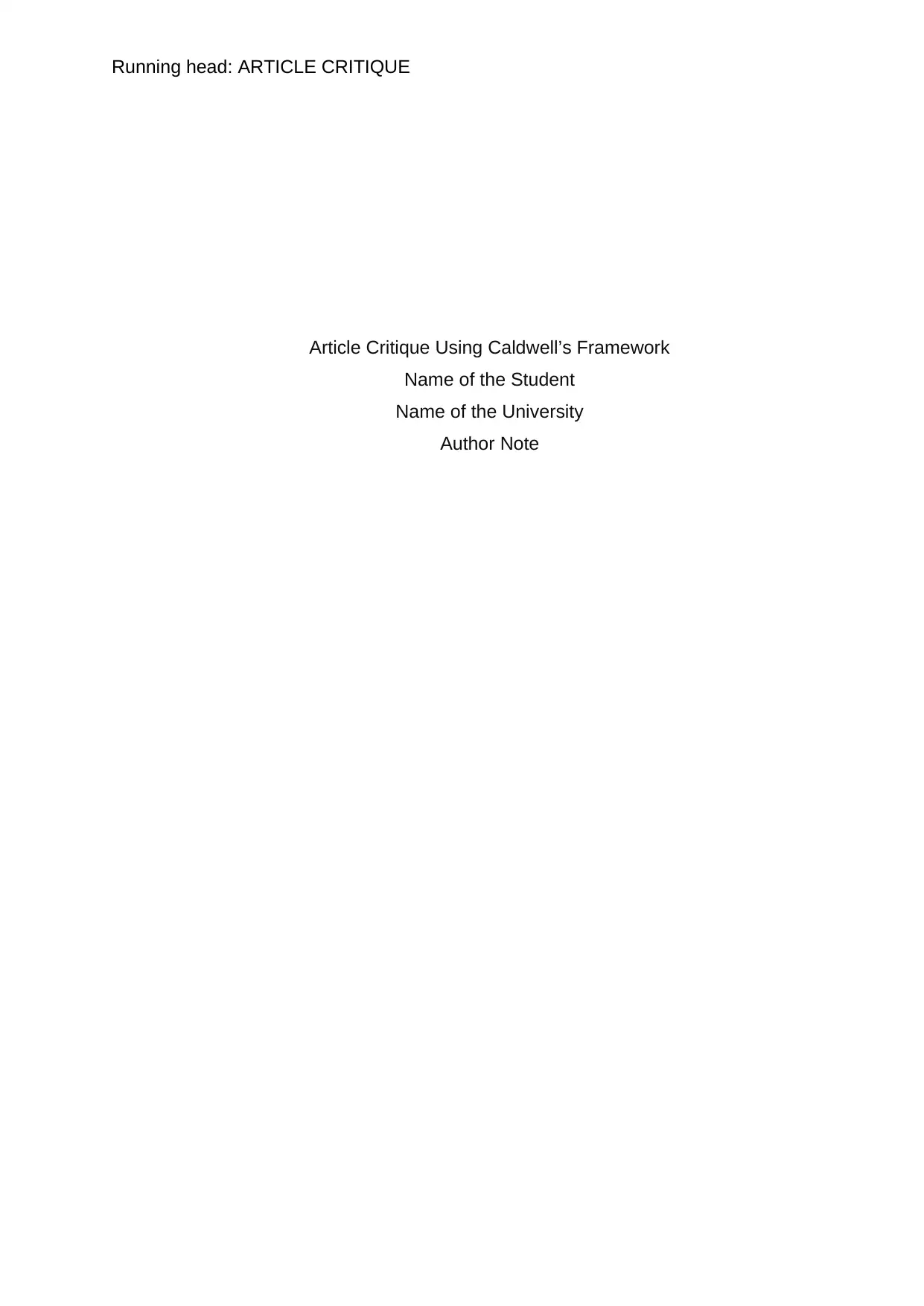
Running head: ARTICLE CRITIQUE
Article Critique Using Caldwell’s Framework
Name of the Student
Name of the University
Author Note
Article Critique Using Caldwell’s Framework
Name of the Student
Name of the University
Author Note
Secure Best Marks with AI Grader
Need help grading? Try our AI Grader for instant feedback on your assignments.
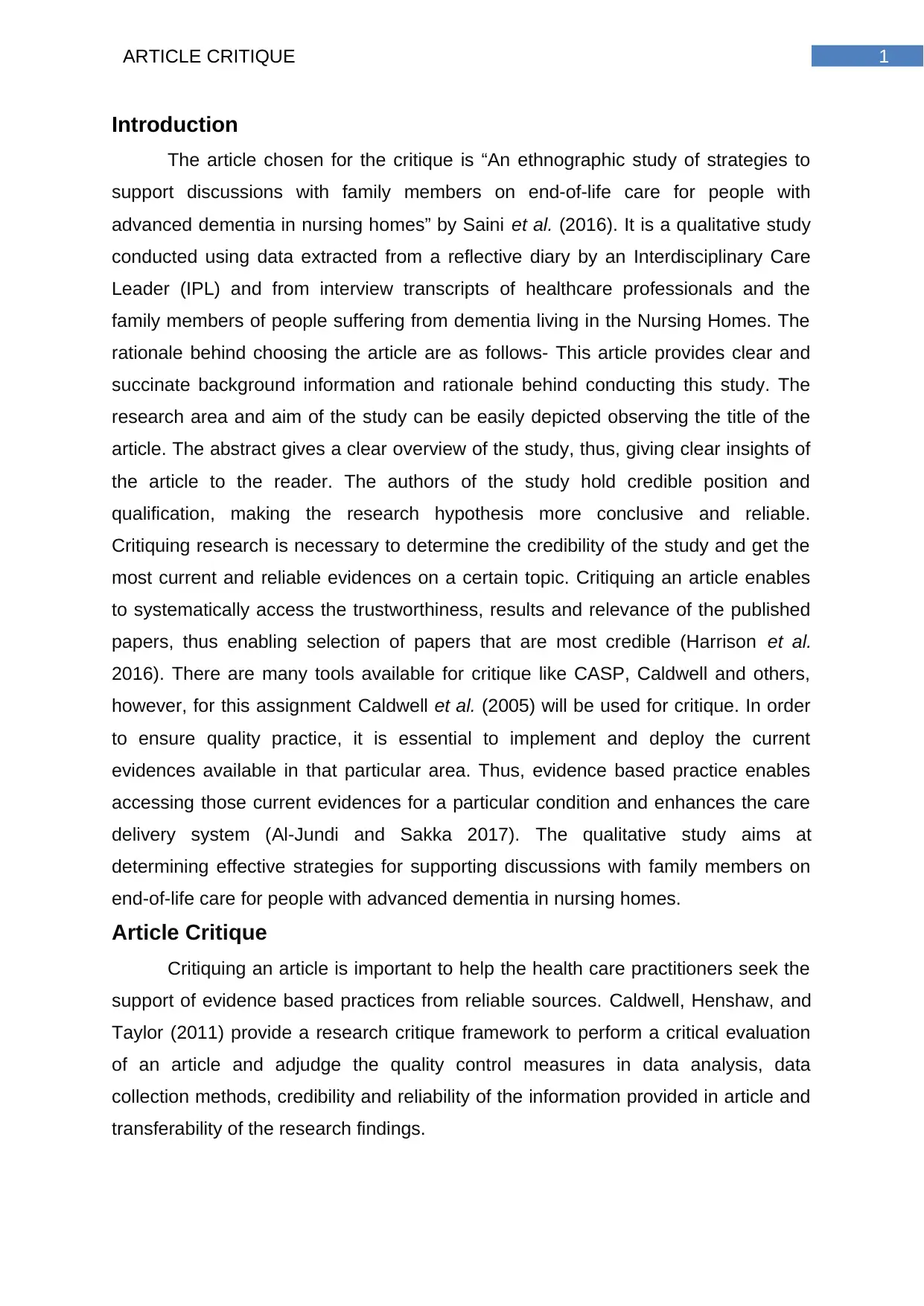
1ARTICLE CRITIQUE
Introduction
The article chosen for the critique is “An ethnographic study of strategies to
support discussions with family members on end-of-life care for people with
advanced dementia in nursing homes” by Saini et al. (2016). It is a qualitative study
conducted using data extracted from a reflective diary by an Interdisciplinary Care
Leader (IPL) and from interview transcripts of healthcare professionals and the
family members of people suffering from dementia living in the Nursing Homes. The
rationale behind choosing the article are as follows- This article provides clear and
succinate background information and rationale behind conducting this study. The
research area and aim of the study can be easily depicted observing the title of the
article. The abstract gives a clear overview of the study, thus, giving clear insights of
the article to the reader. The authors of the study hold credible position and
qualification, making the research hypothesis more conclusive and reliable.
Critiquing research is necessary to determine the credibility of the study and get the
most current and reliable evidences on a certain topic. Critiquing an article enables
to systematically access the trustworthiness, results and relevance of the published
papers, thus enabling selection of papers that are most credible (Harrison et al.
2016). There are many tools available for critique like CASP, Caldwell and others,
however, for this assignment Caldwell et al. (2005) will be used for critique. In order
to ensure quality practice, it is essential to implement and deploy the current
evidences available in that particular area. Thus, evidence based practice enables
accessing those current evidences for a particular condition and enhances the care
delivery system (Al-Jundi and Sakka 2017). The qualitative study aims at
determining effective strategies for supporting discussions with family members on
end-of-life care for people with advanced dementia in nursing homes.
Article Critique
Critiquing an article is important to help the health care practitioners seek the
support of evidence based practices from reliable sources. Caldwell, Henshaw, and
Taylor (2011) provide a research critique framework to perform a critical evaluation
of an article and adjudge the quality control measures in data analysis, data
collection methods, credibility and reliability of the information provided in article and
transferability of the research findings.
Introduction
The article chosen for the critique is “An ethnographic study of strategies to
support discussions with family members on end-of-life care for people with
advanced dementia in nursing homes” by Saini et al. (2016). It is a qualitative study
conducted using data extracted from a reflective diary by an Interdisciplinary Care
Leader (IPL) and from interview transcripts of healthcare professionals and the
family members of people suffering from dementia living in the Nursing Homes. The
rationale behind choosing the article are as follows- This article provides clear and
succinate background information and rationale behind conducting this study. The
research area and aim of the study can be easily depicted observing the title of the
article. The abstract gives a clear overview of the study, thus, giving clear insights of
the article to the reader. The authors of the study hold credible position and
qualification, making the research hypothesis more conclusive and reliable.
Critiquing research is necessary to determine the credibility of the study and get the
most current and reliable evidences on a certain topic. Critiquing an article enables
to systematically access the trustworthiness, results and relevance of the published
papers, thus enabling selection of papers that are most credible (Harrison et al.
2016). There are many tools available for critique like CASP, Caldwell and others,
however, for this assignment Caldwell et al. (2005) will be used for critique. In order
to ensure quality practice, it is essential to implement and deploy the current
evidences available in that particular area. Thus, evidence based practice enables
accessing those current evidences for a particular condition and enhances the care
delivery system (Al-Jundi and Sakka 2017). The qualitative study aims at
determining effective strategies for supporting discussions with family members on
end-of-life care for people with advanced dementia in nursing homes.
Article Critique
Critiquing an article is important to help the health care practitioners seek the
support of evidence based practices from reliable sources. Caldwell, Henshaw, and
Taylor (2011) provide a research critique framework to perform a critical evaluation
of an article and adjudge the quality control measures in data analysis, data
collection methods, credibility and reliability of the information provided in article and
transferability of the research findings.
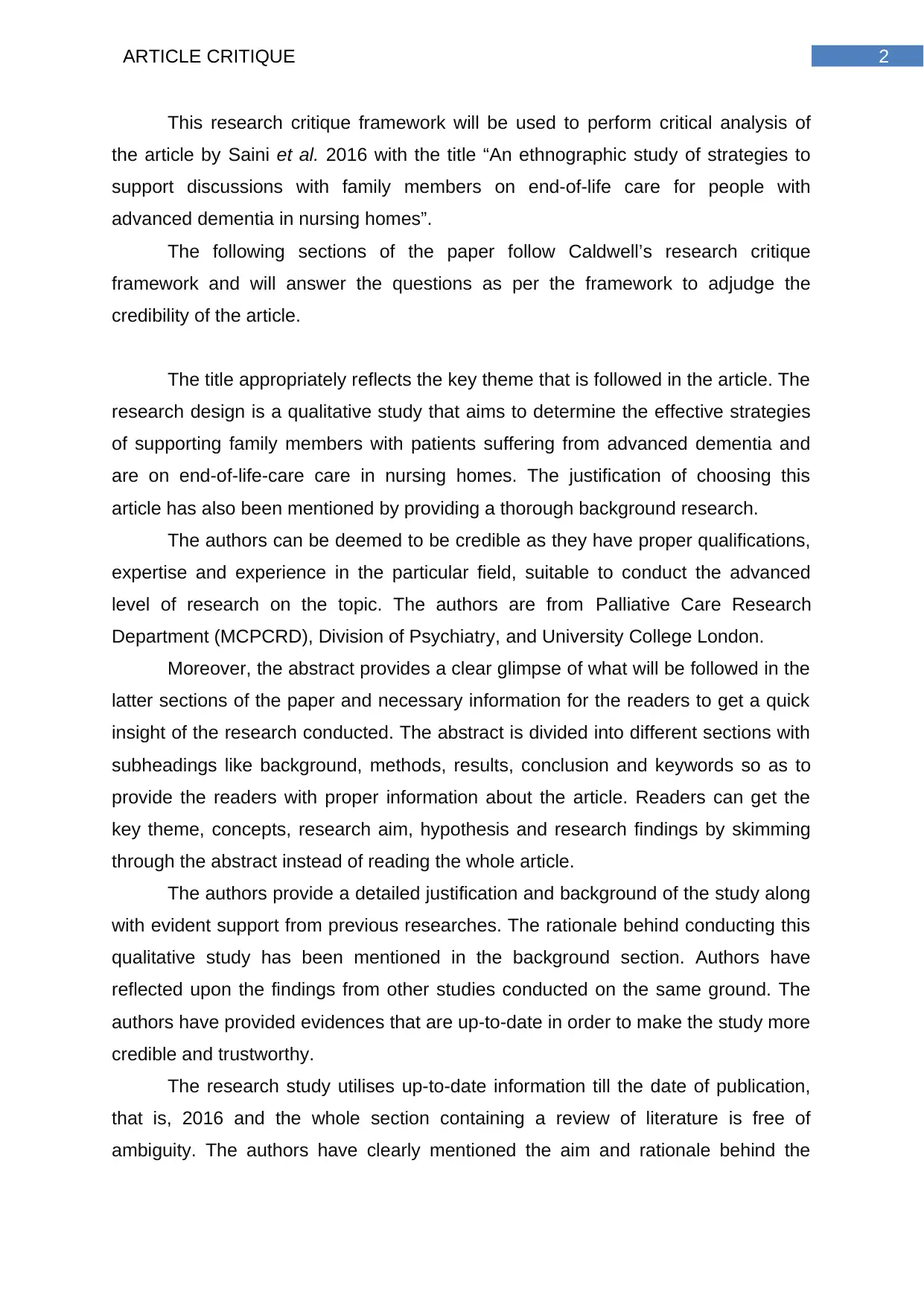
2ARTICLE CRITIQUE
This research critique framework will be used to perform critical analysis of
the article by Saini et al. 2016 with the title “An ethnographic study of strategies to
support discussions with family members on end-of-life care for people with
advanced dementia in nursing homes”.
The following sections of the paper follow Caldwell’s research critique
framework and will answer the questions as per the framework to adjudge the
credibility of the article.
The title appropriately reflects the key theme that is followed in the article. The
research design is a qualitative study that aims to determine the effective strategies
of supporting family members with patients suffering from advanced dementia and
are on end-of-life-care care in nursing homes. The justification of choosing this
article has also been mentioned by providing a thorough background research.
The authors can be deemed to be credible as they have proper qualifications,
expertise and experience in the particular field, suitable to conduct the advanced
level of research on the topic. The authors are from Palliative Care Research
Department (MCPCRD), Division of Psychiatry, and University College London.
Moreover, the abstract provides a clear glimpse of what will be followed in the
latter sections of the paper and necessary information for the readers to get a quick
insight of the research conducted. The abstract is divided into different sections with
subheadings like background, methods, results, conclusion and keywords so as to
provide the readers with proper information about the article. Readers can get the
key theme, concepts, research aim, hypothesis and research findings by skimming
through the abstract instead of reading the whole article.
The authors provide a detailed justification and background of the study along
with evident support from previous researches. The rationale behind conducting this
qualitative study has been mentioned in the background section. Authors have
reflected upon the findings from other studies conducted on the same ground. The
authors have provided evidences that are up-to-date in order to make the study more
credible and trustworthy.
The research study utilises up-to-date information till the date of publication,
that is, 2016 and the whole section containing a review of literature is free of
ambiguity. The authors have clearly mentioned the aim and rationale behind the
This research critique framework will be used to perform critical analysis of
the article by Saini et al. 2016 with the title “An ethnographic study of strategies to
support discussions with family members on end-of-life care for people with
advanced dementia in nursing homes”.
The following sections of the paper follow Caldwell’s research critique
framework and will answer the questions as per the framework to adjudge the
credibility of the article.
The title appropriately reflects the key theme that is followed in the article. The
research design is a qualitative study that aims to determine the effective strategies
of supporting family members with patients suffering from advanced dementia and
are on end-of-life-care care in nursing homes. The justification of choosing this
article has also been mentioned by providing a thorough background research.
The authors can be deemed to be credible as they have proper qualifications,
expertise and experience in the particular field, suitable to conduct the advanced
level of research on the topic. The authors are from Palliative Care Research
Department (MCPCRD), Division of Psychiatry, and University College London.
Moreover, the abstract provides a clear glimpse of what will be followed in the
latter sections of the paper and necessary information for the readers to get a quick
insight of the research conducted. The abstract is divided into different sections with
subheadings like background, methods, results, conclusion and keywords so as to
provide the readers with proper information about the article. Readers can get the
key theme, concepts, research aim, hypothesis and research findings by skimming
through the abstract instead of reading the whole article.
The authors provide a detailed justification and background of the study along
with evident support from previous researches. The rationale behind conducting this
qualitative study has been mentioned in the background section. Authors have
reflected upon the findings from other studies conducted on the same ground. The
authors have provided evidences that are up-to-date in order to make the study more
credible and trustworthy.
The research study utilises up-to-date information till the date of publication,
that is, 2016 and the whole section containing a review of literature is free of
ambiguity. The authors have clearly mentioned the aim and rationale behind the
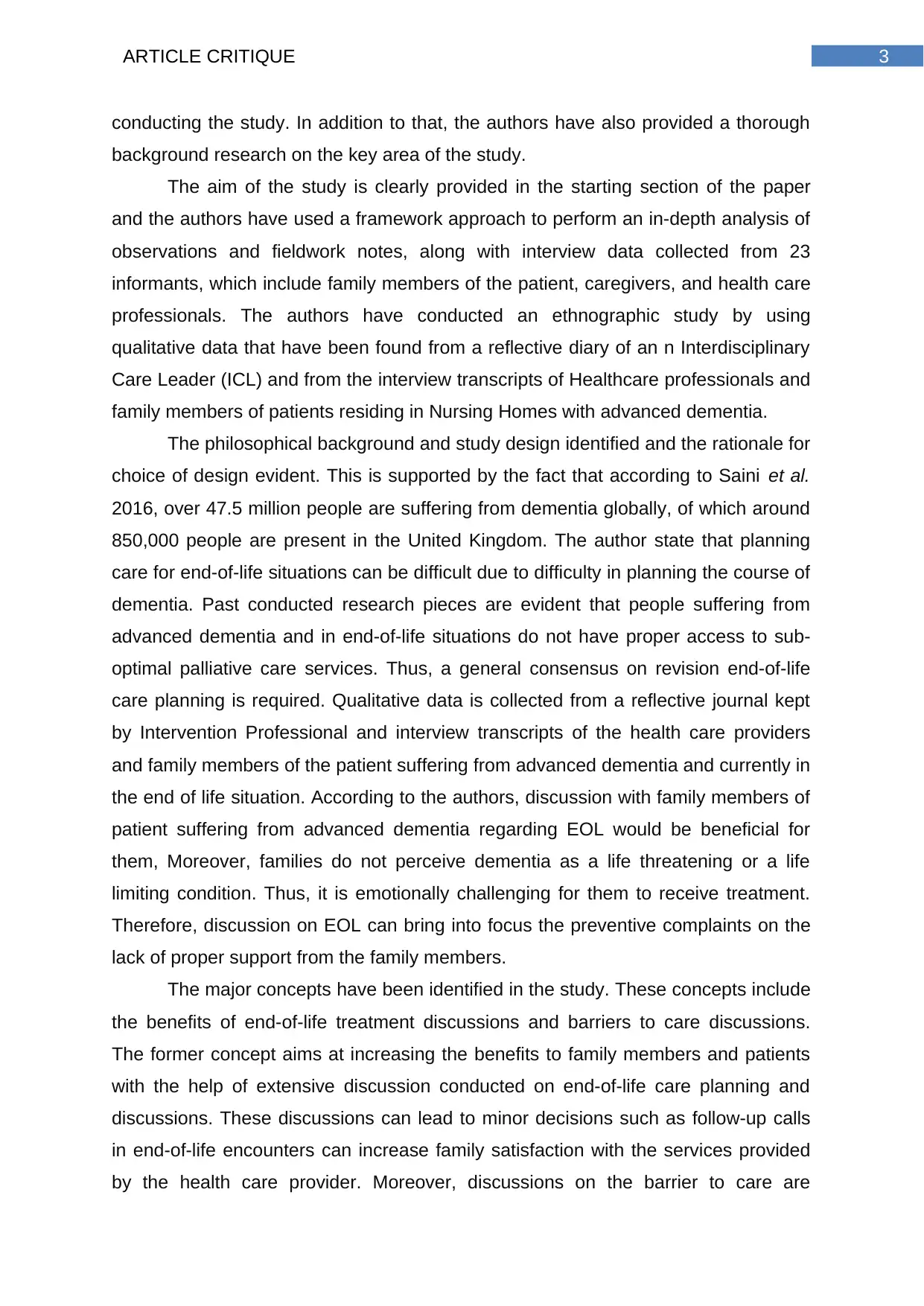
3ARTICLE CRITIQUE
conducting the study. In addition to that, the authors have also provided a thorough
background research on the key area of the study.
The aim of the study is clearly provided in the starting section of the paper
and the authors have used a framework approach to perform an in-depth analysis of
observations and fieldwork notes, along with interview data collected from 23
informants, which include family members of the patient, caregivers, and health care
professionals. The authors have conducted an ethnographic study by using
qualitative data that have been found from a reflective diary of an n Interdisciplinary
Care Leader (ICL) and from the interview transcripts of Healthcare professionals and
family members of patients residing in Nursing Homes with advanced dementia.
The philosophical background and study design identified and the rationale for
choice of design evident. This is supported by the fact that according to Saini et al.
2016, over 47.5 million people are suffering from dementia globally, of which around
850,000 people are present in the United Kingdom. The author state that planning
care for end-of-life situations can be difficult due to difficulty in planning the course of
dementia. Past conducted research pieces are evident that people suffering from
advanced dementia and in end-of-life situations do not have proper access to sub-
optimal palliative care services. Thus, a general consensus on revision end-of-life
care planning is required. Qualitative data is collected from a reflective journal kept
by Intervention Professional and interview transcripts of the health care providers
and family members of the patient suffering from advanced dementia and currently in
the end of life situation. According to the authors, discussion with family members of
patient suffering from advanced dementia regarding EOL would be beneficial for
them, Moreover, families do not perceive dementia as a life threatening or a life
limiting condition. Thus, it is emotionally challenging for them to receive treatment.
Therefore, discussion on EOL can bring into focus the preventive complaints on the
lack of proper support from the family members.
The major concepts have been identified in the study. These concepts include
the benefits of end-of-life treatment discussions and barriers to care discussions.
The former concept aims at increasing the benefits to family members and patients
with the help of extensive discussion conducted on end-of-life care planning and
discussions. These discussions can lead to minor decisions such as follow-up calls
in end-of-life encounters can increase family satisfaction with the services provided
by the health care provider. Moreover, discussions on the barrier to care are
conducting the study. In addition to that, the authors have also provided a thorough
background research on the key area of the study.
The aim of the study is clearly provided in the starting section of the paper
and the authors have used a framework approach to perform an in-depth analysis of
observations and fieldwork notes, along with interview data collected from 23
informants, which include family members of the patient, caregivers, and health care
professionals. The authors have conducted an ethnographic study by using
qualitative data that have been found from a reflective diary of an n Interdisciplinary
Care Leader (ICL) and from the interview transcripts of Healthcare professionals and
family members of patients residing in Nursing Homes with advanced dementia.
The philosophical background and study design identified and the rationale for
choice of design evident. This is supported by the fact that according to Saini et al.
2016, over 47.5 million people are suffering from dementia globally, of which around
850,000 people are present in the United Kingdom. The author state that planning
care for end-of-life situations can be difficult due to difficulty in planning the course of
dementia. Past conducted research pieces are evident that people suffering from
advanced dementia and in end-of-life situations do not have proper access to sub-
optimal palliative care services. Thus, a general consensus on revision end-of-life
care planning is required. Qualitative data is collected from a reflective journal kept
by Intervention Professional and interview transcripts of the health care providers
and family members of the patient suffering from advanced dementia and currently in
the end of life situation. According to the authors, discussion with family members of
patient suffering from advanced dementia regarding EOL would be beneficial for
them, Moreover, families do not perceive dementia as a life threatening or a life
limiting condition. Thus, it is emotionally challenging for them to receive treatment.
Therefore, discussion on EOL can bring into focus the preventive complaints on the
lack of proper support from the family members.
The major concepts have been identified in the study. These concepts include
the benefits of end-of-life treatment discussions and barriers to care discussions.
The former concept aims at increasing the benefits to family members and patients
with the help of extensive discussion conducted on end-of-life care planning and
discussions. These discussions can lead to minor decisions such as follow-up calls
in end-of-life encounters can increase family satisfaction with the services provided
by the health care provider. Moreover, discussions on the barrier to care are
Secure Best Marks with AI Grader
Need help grading? Try our AI Grader for instant feedback on your assignments.
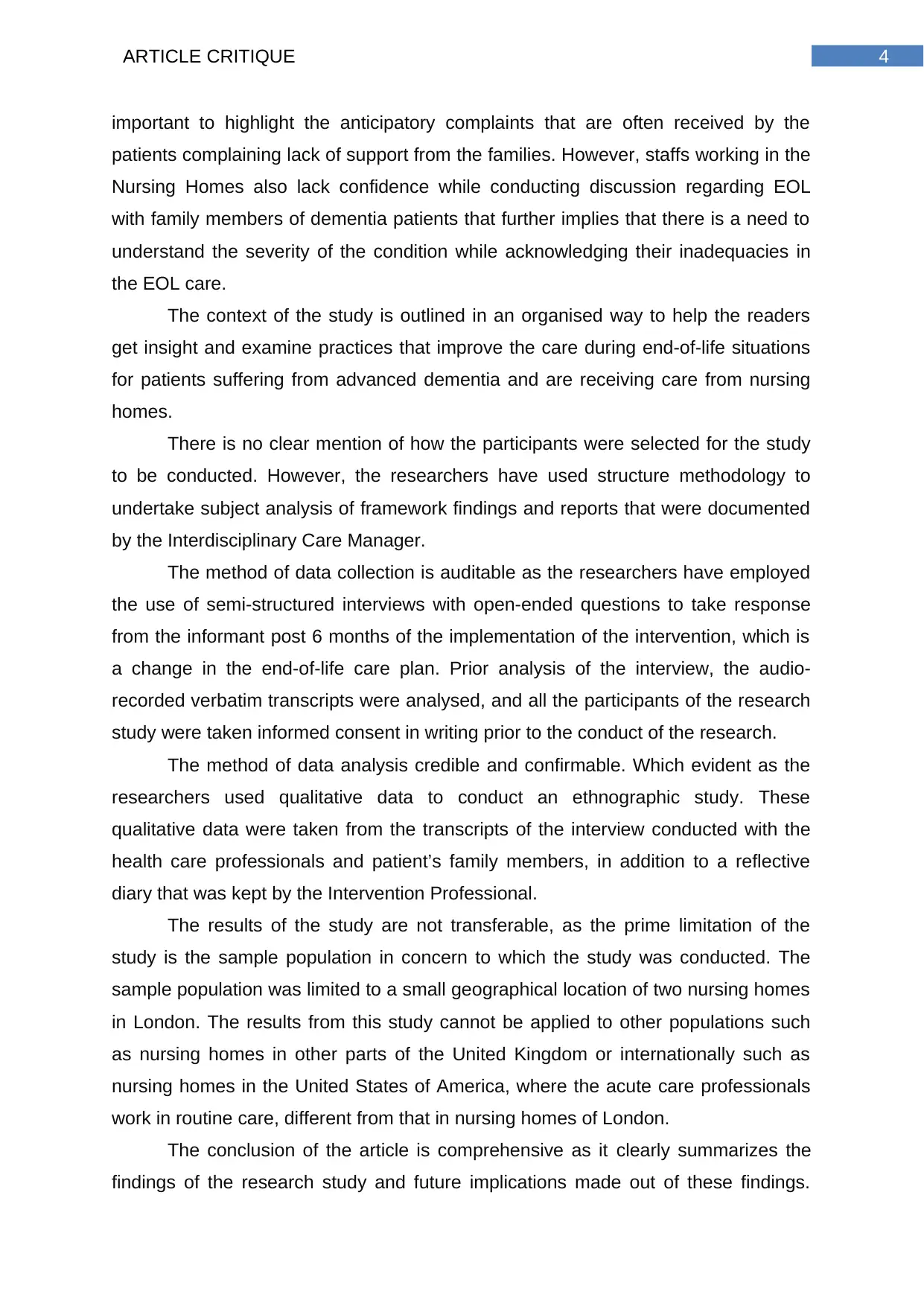
4ARTICLE CRITIQUE
important to highlight the anticipatory complaints that are often received by the
patients complaining lack of support from the families. However, staffs working in the
Nursing Homes also lack confidence while conducting discussion regarding EOL
with family members of dementia patients that further implies that there is a need to
understand the severity of the condition while acknowledging their inadequacies in
the EOL care.
The context of the study is outlined in an organised way to help the readers
get insight and examine practices that improve the care during end-of-life situations
for patients suffering from advanced dementia and are receiving care from nursing
homes.
There is no clear mention of how the participants were selected for the study
to be conducted. However, the researchers have used structure methodology to
undertake subject analysis of framework findings and reports that were documented
by the Interdisciplinary Care Manager.
The method of data collection is auditable as the researchers have employed
the use of semi-structured interviews with open-ended questions to take response
from the informant post 6 months of the implementation of the intervention, which is
a change in the end-of-life care plan. Prior analysis of the interview, the audio-
recorded verbatim transcripts were analysed, and all the participants of the research
study were taken informed consent in writing prior to the conduct of the research.
The method of data analysis credible and confirmable. Which evident as the
researchers used qualitative data to conduct an ethnographic study. These
qualitative data were taken from the transcripts of the interview conducted with the
health care professionals and patient’s family members, in addition to a reflective
diary that was kept by the Intervention Professional.
The results of the study are not transferable, as the prime limitation of the
study is the sample population in concern to which the study was conducted. The
sample population was limited to a small geographical location of two nursing homes
in London. The results from this study cannot be applied to other populations such
as nursing homes in other parts of the United Kingdom or internationally such as
nursing homes in the United States of America, where the acute care professionals
work in routine care, different from that in nursing homes of London.
The conclusion of the article is comprehensive as it clearly summarizes the
findings of the research study and future implications made out of these findings.
important to highlight the anticipatory complaints that are often received by the
patients complaining lack of support from the families. However, staffs working in the
Nursing Homes also lack confidence while conducting discussion regarding EOL
with family members of dementia patients that further implies that there is a need to
understand the severity of the condition while acknowledging their inadequacies in
the EOL care.
The context of the study is outlined in an organised way to help the readers
get insight and examine practices that improve the care during end-of-life situations
for patients suffering from advanced dementia and are receiving care from nursing
homes.
There is no clear mention of how the participants were selected for the study
to be conducted. However, the researchers have used structure methodology to
undertake subject analysis of framework findings and reports that were documented
by the Interdisciplinary Care Manager.
The method of data collection is auditable as the researchers have employed
the use of semi-structured interviews with open-ended questions to take response
from the informant post 6 months of the implementation of the intervention, which is
a change in the end-of-life care plan. Prior analysis of the interview, the audio-
recorded verbatim transcripts were analysed, and all the participants of the research
study were taken informed consent in writing prior to the conduct of the research.
The method of data analysis credible and confirmable. Which evident as the
researchers used qualitative data to conduct an ethnographic study. These
qualitative data were taken from the transcripts of the interview conducted with the
health care professionals and patient’s family members, in addition to a reflective
diary that was kept by the Intervention Professional.
The results of the study are not transferable, as the prime limitation of the
study is the sample population in concern to which the study was conducted. The
sample population was limited to a small geographical location of two nursing homes
in London. The results from this study cannot be applied to other populations such
as nursing homes in other parts of the United Kingdom or internationally such as
nursing homes in the United States of America, where the acute care professionals
work in routine care, different from that in nursing homes of London.
The conclusion of the article is comprehensive as it clearly summarizes the
findings of the research study and future implications made out of these findings.
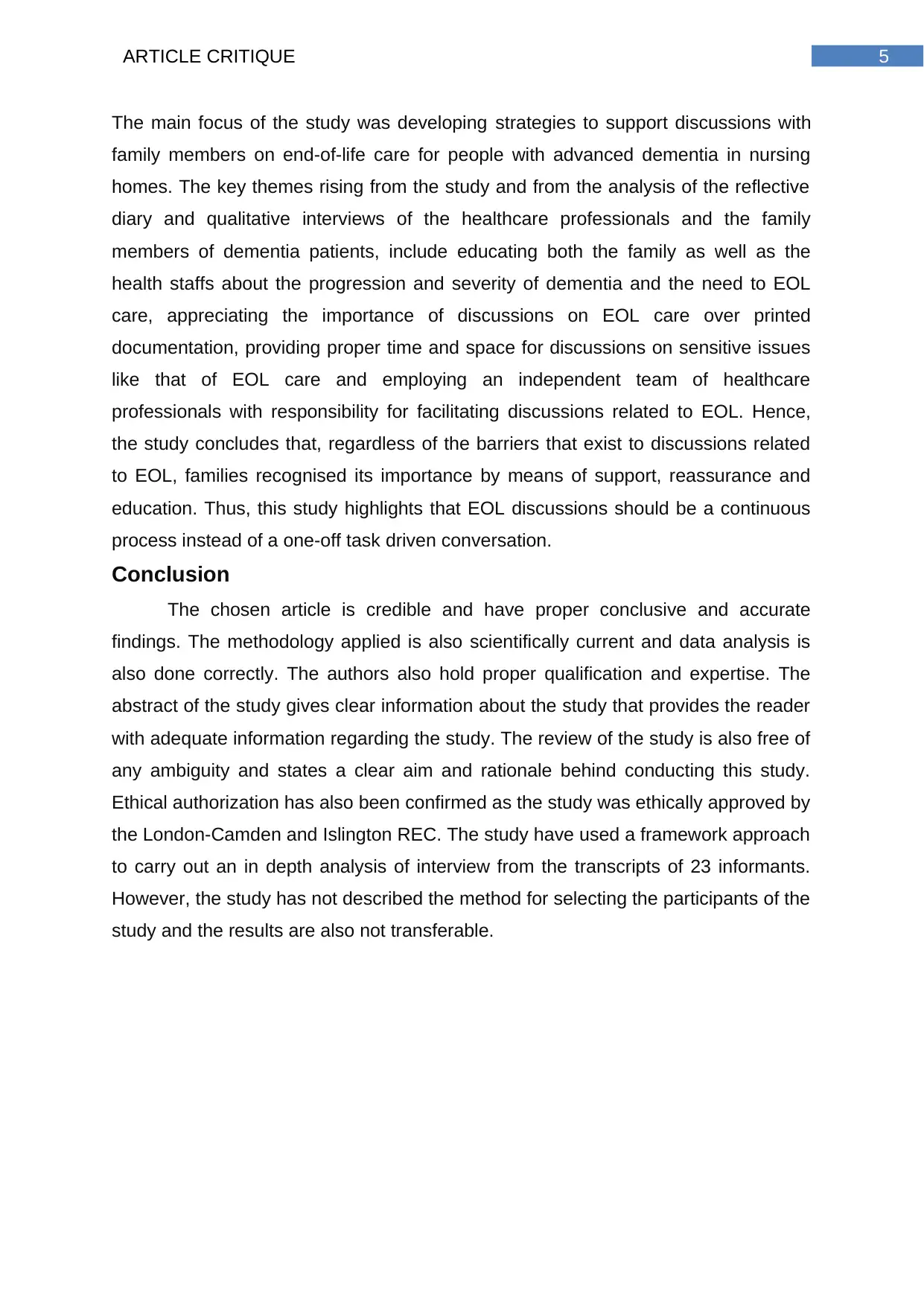
5ARTICLE CRITIQUE
The main focus of the study was developing strategies to support discussions with
family members on end-of-life care for people with advanced dementia in nursing
homes. The key themes rising from the study and from the analysis of the reflective
diary and qualitative interviews of the healthcare professionals and the family
members of dementia patients, include educating both the family as well as the
health staffs about the progression and severity of dementia and the need to EOL
care, appreciating the importance of discussions on EOL care over printed
documentation, providing proper time and space for discussions on sensitive issues
like that of EOL care and employing an independent team of healthcare
professionals with responsibility for facilitating discussions related to EOL. Hence,
the study concludes that, regardless of the barriers that exist to discussions related
to EOL, families recognised its importance by means of support, reassurance and
education. Thus, this study highlights that EOL discussions should be a continuous
process instead of a one-off task driven conversation.
Conclusion
The chosen article is credible and have proper conclusive and accurate
findings. The methodology applied is also scientifically current and data analysis is
also done correctly. The authors also hold proper qualification and expertise. The
abstract of the study gives clear information about the study that provides the reader
with adequate information regarding the study. The review of the study is also free of
any ambiguity and states a clear aim and rationale behind conducting this study.
Ethical authorization has also been confirmed as the study was ethically approved by
the London-Camden and Islington REC. The study have used a framework approach
to carry out an in depth analysis of interview from the transcripts of 23 informants.
However, the study has not described the method for selecting the participants of the
study and the results are also not transferable.
The main focus of the study was developing strategies to support discussions with
family members on end-of-life care for people with advanced dementia in nursing
homes. The key themes rising from the study and from the analysis of the reflective
diary and qualitative interviews of the healthcare professionals and the family
members of dementia patients, include educating both the family as well as the
health staffs about the progression and severity of dementia and the need to EOL
care, appreciating the importance of discussions on EOL care over printed
documentation, providing proper time and space for discussions on sensitive issues
like that of EOL care and employing an independent team of healthcare
professionals with responsibility for facilitating discussions related to EOL. Hence,
the study concludes that, regardless of the barriers that exist to discussions related
to EOL, families recognised its importance by means of support, reassurance and
education. Thus, this study highlights that EOL discussions should be a continuous
process instead of a one-off task driven conversation.
Conclusion
The chosen article is credible and have proper conclusive and accurate
findings. The methodology applied is also scientifically current and data analysis is
also done correctly. The authors also hold proper qualification and expertise. The
abstract of the study gives clear information about the study that provides the reader
with adequate information regarding the study. The review of the study is also free of
any ambiguity and states a clear aim and rationale behind conducting this study.
Ethical authorization has also been confirmed as the study was ethically approved by
the London-Camden and Islington REC. The study have used a framework approach
to carry out an in depth analysis of interview from the transcripts of 23 informants.
However, the study has not described the method for selecting the participants of the
study and the results are also not transferable.
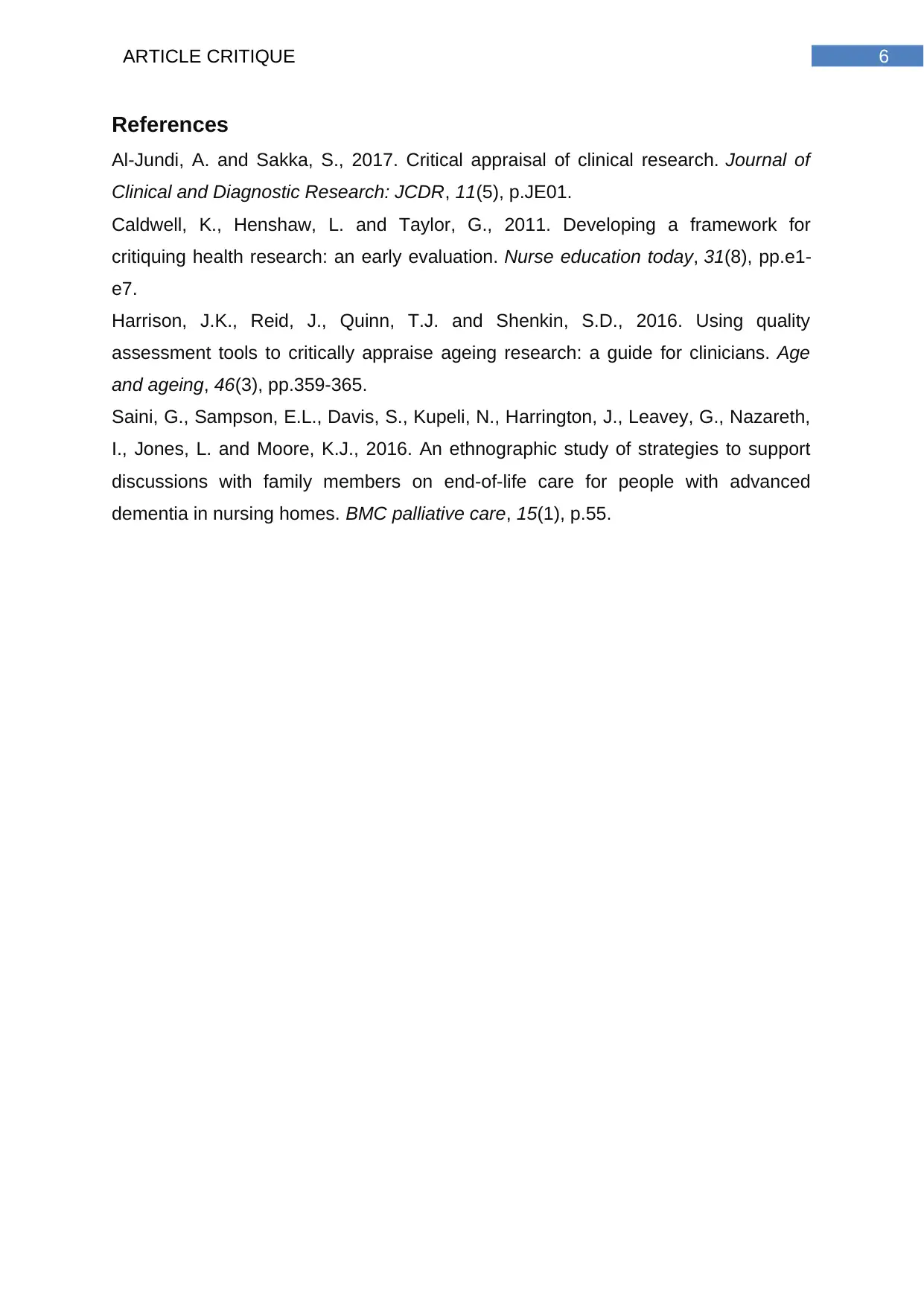
6ARTICLE CRITIQUE
References
Al-Jundi, A. and Sakka, S., 2017. Critical appraisal of clinical research. Journal of
Clinical and Diagnostic Research: JCDR, 11(5), p.JE01.
Caldwell, K., Henshaw, L. and Taylor, G., 2011. Developing a framework for
critiquing health research: an early evaluation. Nurse education today, 31(8), pp.e1-
e7.
Harrison, J.K., Reid, J., Quinn, T.J. and Shenkin, S.D., 2016. Using quality
assessment tools to critically appraise ageing research: a guide for clinicians. Age
and ageing, 46(3), pp.359-365.
Saini, G., Sampson, E.L., Davis, S., Kupeli, N., Harrington, J., Leavey, G., Nazareth,
I., Jones, L. and Moore, K.J., 2016. An ethnographic study of strategies to support
discussions with family members on end-of-life care for people with advanced
dementia in nursing homes. BMC palliative care, 15(1), p.55.
References
Al-Jundi, A. and Sakka, S., 2017. Critical appraisal of clinical research. Journal of
Clinical and Diagnostic Research: JCDR, 11(5), p.JE01.
Caldwell, K., Henshaw, L. and Taylor, G., 2011. Developing a framework for
critiquing health research: an early evaluation. Nurse education today, 31(8), pp.e1-
e7.
Harrison, J.K., Reid, J., Quinn, T.J. and Shenkin, S.D., 2016. Using quality
assessment tools to critically appraise ageing research: a guide for clinicians. Age
and ageing, 46(3), pp.359-365.
Saini, G., Sampson, E.L., Davis, S., Kupeli, N., Harrington, J., Leavey, G., Nazareth,
I., Jones, L. and Moore, K.J., 2016. An ethnographic study of strategies to support
discussions with family members on end-of-life care for people with advanced
dementia in nursing homes. BMC palliative care, 15(1), p.55.
1 out of 7
Related Documents
Your All-in-One AI-Powered Toolkit for Academic Success.
+13062052269
info@desklib.com
Available 24*7 on WhatsApp / Email
![[object Object]](/_next/static/media/star-bottom.7253800d.svg)
Unlock your academic potential
© 2024 | Zucol Services PVT LTD | All rights reserved.





